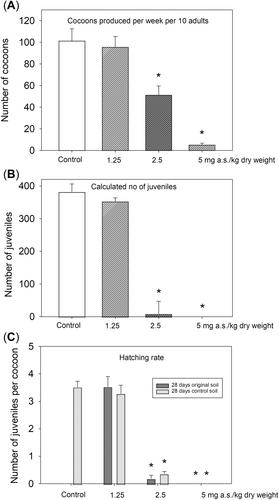下载PDF
{"title":"Advancing Soil Risk Assessment: A Novel Earthworm Cocoon Test with a Complementary Toxicokinetic–Toxicodynamic Modeling Approach","authors":"Kim Rakel, Vanessa Roeben, Gregor Ernst, Andre Gergs","doi":"10.1002/etc.5976","DOIUrl":null,"url":null,"abstract":"<p>In the current European Union pesticide risk assessment for soil organisms, effect endpoints from laboratory studies (Tier 1) and field studies (higher-tier risk assessment) are compared with predicted environmental concentrations in soil, derived from the proposed use pattern. The simple but conservative initial Tier 1 risk assessment considers a range of worst-case assumptions. In contrast, the higher-tier assessment focuses on specific conditions tested in the corresponding field study. Effect modeling, such as toxicokinetic–toxicodynamic (TKTD) modeling, is considered a promising future tool to address uncertainties in soil risk assessment, such as extrapolation to different ecological, pedo-climatical, or agronomical situations, or to serve as an intermediate tier for potential refinement of the risk assessment. For the implementation of TKTD modeling in soil organism risk assessment, data on earthworm growth and reproduction over time are required, which are not provided by the standard Organisation for Economic Co-operation and Development (OECD) 222 laboratory test. The underlying study with carbendazim presents a new earthworm cocoon test design, based on the OECD 222 test, to provide the necessary data as input for TKTD modeling. This proposed test design involves destructive samplings at days 7, 14, 21, and 28, enabling the determination of growth, cocoon number, and the number of juveniles hatched per cocoon in 7-day intervals. The new cocoon test allowed the disentanglement of the toxic effect of carbendazim in earthworms: At the highest concentration prominent effects on growth and reproductive output were observed, and the number of cocoons was significantly reduced compared to control. The results highlighted different physiological modes of action: effect on growth via higher maintenance costs as a primary mode of action as well as a reduced number of cocoons (effect on reproduction) and a lower number of juveniles hatching from each cocoon (hazard during oogenesis) as a secondary mode of action. We provide an example of how this new test's data can be used to feed a dynamic energy budget theory–TKTD model of <i>Eisenia fetida</i>. We also validate it against the original OECD 222 test design, outlining its potential future use in soil risk assessment. <i>Environ Toxicol Chem</i> 2024;43:2377–2386. © 2024 The Author(s). <i>Environmental Toxicology and Chemistry</i> published by Wiley Periodicals LLC on behalf of SETAC.</p>","PeriodicalId":11793,"journal":{"name":"Environmental Toxicology and Chemistry","volume":"43 11","pages":"2377-2386"},"PeriodicalIF":3.6000,"publicationDate":"2024-08-22","publicationTypes":"Journal Article","fieldsOfStudy":null,"isOpenAccess":false,"openAccessPdf":"https://onlinelibrary.wiley.com/doi/epdf/10.1002/etc.5976","citationCount":"0","resultStr":null,"platform":"Semanticscholar","paperid":null,"PeriodicalName":"Environmental Toxicology and Chemistry","FirstCategoryId":"93","ListUrlMain":"https://onlinelibrary.wiley.com/doi/10.1002/etc.5976","RegionNum":4,"RegionCategory":"环境科学与生态学","ArticlePicture":[],"TitleCN":null,"AbstractTextCN":null,"PMCID":null,"EPubDate":"","PubModel":"","JCR":"Q2","JCRName":"ENVIRONMENTAL SCIENCES","Score":null,"Total":0}
引用次数: 0
引用
批量引用
Abstract
In the current European Union pesticide risk assessment for soil organisms, effect endpoints from laboratory studies (Tier 1) and field studies (higher-tier risk assessment) are compared with predicted environmental concentrations in soil, derived from the proposed use pattern. The simple but conservative initial Tier 1 risk assessment considers a range of worst-case assumptions. In contrast, the higher-tier assessment focuses on specific conditions tested in the corresponding field study. Effect modeling, such as toxicokinetic–toxicodynamic (TKTD) modeling, is considered a promising future tool to address uncertainties in soil risk assessment, such as extrapolation to different ecological, pedo-climatical, or agronomical situations, or to serve as an intermediate tier for potential refinement of the risk assessment. For the implementation of TKTD modeling in soil organism risk assessment, data on earthworm growth and reproduction over time are required, which are not provided by the standard Organisation for Economic Co-operation and Development (OECD) 222 laboratory test. The underlying study with carbendazim presents a new earthworm cocoon test design, based on the OECD 222 test, to provide the necessary data as input for TKTD modeling. This proposed test design involves destructive samplings at days 7, 14, 21, and 28, enabling the determination of growth, cocoon number, and the number of juveniles hatched per cocoon in 7-day intervals. The new cocoon test allowed the disentanglement of the toxic effect of carbendazim in earthworms: At the highest concentration prominent effects on growth and reproductive output were observed, and the number of cocoons was significantly reduced compared to control. The results highlighted different physiological modes of action: effect on growth via higher maintenance costs as a primary mode of action as well as a reduced number of cocoons (effect on reproduction) and a lower number of juveniles hatching from each cocoon (hazard during oogenesis) as a secondary mode of action. We provide an example of how this new test's data can be used to feed a dynamic energy budget theory–TKTD model of Eisenia fetida . We also validate it against the original OECD 222 test design, outlining its potential future use in soil risk assessment. Environ Toxicol Chem 2024;43:2377–2386. © 2024 The Author(s). Environmental Toxicology and Chemistry published by Wiley Periodicals LLC on behalf of SETAC.
推进土壤风险评估:新型蚯蚓茧测试与毒代动力学-毒效学模型互补方法。
在目前欧盟针对土壤生物的农药风险评估中,实验室研究(第 1 级)和实地研究(更高 级的风险评估)的效应终点与根据拟议使用模式得出的土壤环境浓度预测值进行比较。简单而保守的初步一级风险评估考虑了一系列最坏情况假设。相比之下,更高层次的评估侧重于在相应的实地研究中测试的特定条件。效应建模(如毒动学-毒效学 (TKTD) 建模)被认为是一种很有前途的未来工具,可用于解决土壤风险评估中的不确定性问题,如推断不同的生态、植物-气候或农艺情况,或作为风险评估可能改进的中间层。在土壤生物风险评估中实施 TKTD 模型时,需要蚯蚓随时间生长和繁殖的数据,而标准的经济合作与发展组织 (OECD) 222 实验室测试并不提供这些数据。关于多菌灵的基础研究提出了一种新的蚯蚓茧试验设计,以经合组织 222 试验为基础,为 TKTD 建模提供必要的输入数据。这种拟议的试验设计包括在第 7、14、21 和 28 天进行破坏性取样,从而能够以 7 天为间隔确定蚯蚓的生长情况、蚕茧数量以及每个蚕茧孵化的幼虫数量。通过新的蚕茧试验,可以解除多菌灵对蚯蚓的毒性影响:与对照组相比,在最高浓度下,蚯蚓的生长和生殖能力受到显著影响,茧的数量也明显减少。结果凸显了不同的生理作用模式:作为主要作用模式,通过提高维持成本影响生长;作为次要作用模式,减少蚕茧数量(对繁殖的影响)和降低每个蚕茧孵化的幼虫数量(卵发生过程中的危害)。我们举例说明了如何利用这一新的测试数据来为埃森藻的动态能量预算理论--TKTD 模型提供依据。我们还根据最初的 OECD 222 试验设计对其进行了验证,并概述了其未来在土壤风险评估中的潜在用途。环境毒物化学 2024;00:1-10。© 2024 作者。环境毒理学与化学》由 Wiley Periodicals LLC 代表 SETAC 出版。
本文章由计算机程序翻译,如有差异,请以英文原文为准。


